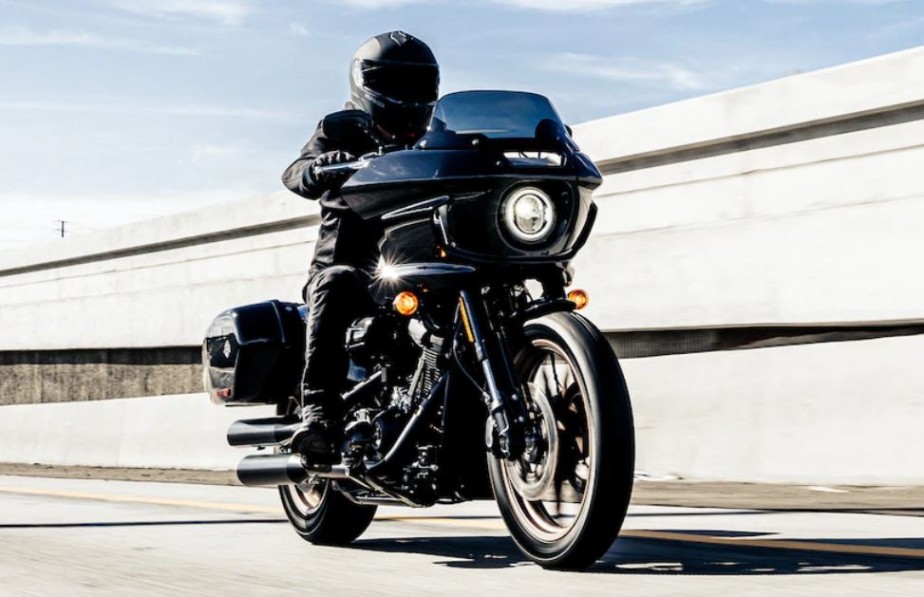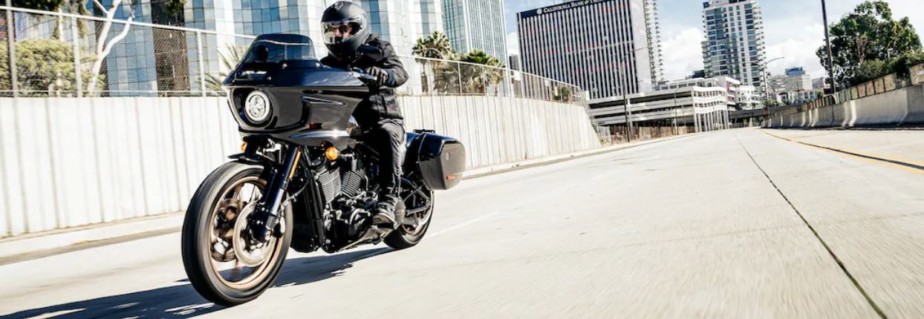
When the Big Twin was dropped by the company in 2017, Harley-Davidson enthusiasts lamented the “Death of the Dyna.” For fans of the Dyna, the cruiser was more than just a Harley; it was a part of their identity, and their loss caused them to question and dislike the Milwaukee-Eight Softails, which served as the Dyna’s replacement. In light of those facts, the combined cruiser family started off up against it with the Harley faithful.
When The Motor Company unveiled the Super Glide II in 1982, the FXR received the same response. Closely follows in 1983 was the FXRT Sport Glide, but the platform wasn’t powered with the renowned 1,340cc Evolution V-twin until 1984. However, the brand’s core disapproved of the FXR’s “contemporary” style and mill, which led to the Dyna’s launch by 1991. (we all know how that story ends).
Five years after the Dyna’s collapse, both outcasts are currently fashionable. The M8 Softails have won over brand aficionados, particularly ardent Dyna supporters. Second-hand FXRs fetch top value on the used market. Many people who can’t afford or won’t buy an old Sport Glide turn to the aftermarket and attach a fake FXRT fairing to an M8 Softail. It didn’t take long for the design team at Harley-Davidson to notice that pattern.
The 2022 Low Rider ST borrows from the past while forging a new route all its own, trading the smooth and bulbous form of the FXRT fairing for an aggressive, angular design. Harley’s ST line, which stands for Sport-Touring, combines cross-country heritage with performance. We took a 700-mile road trip along California’s Golden Coast to test whether the Low Rider-turned-bagger could live up to that ST tag and its Sport Glide roots.
Table of Contents
What Are the 2022 Harley-Davidson Low-Rider Characteristics?
Here you can see the specifications of the 2022 Harley-Davidson Low-Rider.
| STANDARD FEATURES |
|---|
| Standard Anti-Lock Braking System (ABS) |
| Hidden, free piston, coil-over monoshock; 56mm stroke; hydraulic preload adjustment |
| Single cartridge 43 mm inverted with aluminum fork triple clamps; single rate spring |
| LED, low beam, high beam and signature position headlight |
| Smart Security System with proximity-based, hands-free security fob. |
| DIMENSIONS | |
|---|---|
| LENGTH | 2,365 mm |
| SEAT HEIGHT, UNLADEN | 720 mm |
| GROUND CLEARANCE | 150 mm |
| RAKE | 28 |
| TRAIL | 145 mm |
| WHEELBASE | 1,615 mm |
| TYRES, FRONT SPECIFICATION | 110/90B19,62H,BW |
| TYRES, REAR SPECIFICATION | 180/70B16,77H,BW |
| TYRE, TYPE | Michelin™ Scorcher™ “31” front and rear |
| FUEL CAPACITY | 18.9 l |
| OIL CAPACITY (W/FILTER) | 4.7 l |
| WEIGHT, AS SHIPPED | 315 kg |
| WEIGHT, IN RUNNING ORDER | 327 kg |
| LUGGAGE CAPACITY -VOLUME | 0.05 m3 |
| ENGINE | |
|---|---|
| ENGINE | Milwaukee-Eight™ 117 |
| BORE | 103.5 mm |
| STROKE | 114.3 mm |
| DISPLACEMENT | 1,923 cc |
| COMPRESSION RATIO | 10.2:1 |
| FUEL SYSTEM | Electronic Sequential Port Fuel Injection (ESPFI) |
| EXHAUST | 2-into-2 offset shotgun; catalyst in muffler |
| PERFORMANCE | |
|---|---|
| ENGINE TORQUE TESTING METHOD | EC 134/2014 |
| ENGINE TORQUE | 168 Nm |
| ENGINE TORQUE (RPM) | 3500 |
| HORSEPOWER | 105 HP / 78 kW @ 5020 rpm |
| LEAN ANGLE, RIGHT (DEG.) | 30 |
| LEAN ANGLE, LEFT (DEG.) | 30 |
| FUEL ECONOMY TESTING METHOD | EU 134/2014 |
| FUEL ECONOMY | 5.5 l/100 km |
| CO2 EMISSIONS TESTING METHOD | EU 134/2014 |
| CO2 EMISSIONS | 128 g/km CO2 |
| DRIVE TRAIN | |
|---|---|
| PRIMARY DRIVE | Chain, 34/46 ratio |
| GEAR RATIOS (OVERALL) 1ST | 9.311 |
| GEAR RATIOS (OVERALL) 2ND | 6.454 |
| GEAR RATIOS (OVERALL) 3RD | 4.793 |
| GEAR RATIOS (OVERALL) 4TH | 3.882 |
| GEAR RATIOS (OVERALL) 5TH | 3.307 |
| GEAR RATIOS (OVERALL) 6TH | 2.79 |
| CHASSIS | |
|---|---|
| FRONT FORK | Single cartridge 43 mm inverted with aluminum fork triple clamps; single rate spring |
| REAR SHOCKS | Hidden, free piston, coil-over monoshock; 56 mm stroke; hydraulic preload adjustment |
| WHEELS, FRONT TYPE | Dark bronze, Radiate cast aluminum wheel |
| WHEELS, REAR TYPE | Dark bronze, Radiate cast aluminum wheel |
| BRAKES, TYPE | Front and rear black, Split 7-spoke floating rotors |
| BRAKES, CALIPER TYPE | 4-piston fixed front and 2-piston floating rear |
| ELECTRIC | |
|---|---|
| LIGHTS (AS PER COUNTRY REGULATION), INDICATOR LAMPS | All LED, low beam, high beam and signature position lamp headlamp; LED Zeppelin Tail/Stop; Incandescent bullet turn signals |
| GAUGES | 4-inch analog tachometer with digital speedometer, gear, odometer, fuel level, clock, trip and range indication |
Sport

When The Motor Company created the air/oil-cooled Milwaukee-Eight V-Twin, they improved the rider experience. The M8’s rubber mounting and counterbalanced design reduce vibration while maintaining the Big Twin Hogs’ distinctive sound. The Milwaukee-Eight 117ci (1,923cc), the engine at the center of the 2022 Low Rider ST, represents an even greater refining by the engineers.
If the nearly two-liter displacement figure wasn’t amazing enough, the company’s largest production M8 produces 125 lb-ft of torque thanks to a high-performance cam and forward-facing Heavy Breather intake (at 3,500 rpm).
Despite its impressive feature list, the Milwaukee-Eight 117 is unexpectedly warm. Roll-on response is most immediate once peak torque is reached at 3,500 rpm, but it begins to fade at 4,000 rpm.
The V-twin prioritizes smooth acceleration over tons of low-down pull. Although the linear powerband may not be exciting, the 721-pound cruiser was easier to control over the wavy Pacific Coast Highway due to the power pulses’ predictability.
The Low Rider ST’s even-keeled temperament, however, is ideally suited for long-distance travel. The tachometer read only 2,500 rpm at 70 mph while in sixth gear. The rider was able to repeatedly pound the pavement for hours on end because to the sluggish engine speed’s practically vibration-free ride.
Harley’s cruise control technology contributed to the ST’s highway prowess as well. In an emergency, slamming the throttle didn’t trip the system; instead, it allowed for quick and accurate speed adjustments.
Additionally, H-D adjusted the ST’s chassis for greater comfort on the Interstate. The 43mm USD fork now has single-rate springs, while the free-piston monoshock has a 4.4 inch travel and 2.2 inch stroke.
In addition to raising the rear end and overall ride height, the additional rear travel also prepares the chassis’ geometry for the sporting goals of the ST. To fulfill the requirements of the brief for touring, Harley abandoned the internals of its dual-bending valve fork in favor of a ride akin to a magic carpet provided by the single-rate springs.
The cruiser’s composed driving style was unaffected by even the most severe collisions and large potholes. The longer shock ensured that the Low Rider never bottomed out, but that soft ride comes at a cost. The ST’s feedback and reaction in the esses suffered from the suspension’s mild springing. The baby bagger can still glide over the curves with ease despite that hazy feeling, but the ST likes flowing asphalt ribbons to squiggly twists and turns.
Touring
With the Low Rider ST, the front fairing with FXRT influences takes center stage, yet it’s more than just a design experiment. The frame-mounted shielding diffuses the incoming air sufficiently to reduce turbulence, but wind still danced off my shoulders and the bottom of the helmet.
Inlets at the sides and under the windscreen assist in balancing that flow and improve ventilation in hotter weather. The stock windscreen did wonders for my five-foot, ten-inch frame. Naturally, individuals in need of greater security can purchase a higher shield from Harley’s accessory selection.
Although the Grand American Touring line’s inner fairing may be more opulent than that of the ST, the manufacturer goes above and above with other cockpit amenities. High handlebars from the Low Rider S are still present, but larger pullback risers more comfortably place the riders’ hands directly below the shoulders. On top of those new risers, Harley installs the same LCD instrument cluster that debuted on the Softail Street Bob model.
The Low Rider’s distinctive tank-mounted speedo and tachometer are replaced by the bar-mounted monitor, and the results are astounding. Instead of looking down at the tank console to take my eyes off the road, I rapidly gathered important information like speed, gear position, and rpm at a glance.
The sleek new single-seat arrangement of the ST leans toward its athletic side, and the seat pan still had enough for my bony behind. Long slogs up California’s Highway 101 were not only doable, but also comfortable thanks to the plush padding and excellent lumbar support.
I personally favor Harley-mid-mounted Davidson’s pegs for more control in the twisties because I have a 32-inch inseam. When seated, my knees were 90 degrees bent, but individuals with longer legs may want to invest in a set of forward controls or a highway pegs/crash bar arrangement.
The ST may borrow from its close relatives, the FXRT for its appearance and the Street Bob for its digital gauge. The most recent Low Rider borrows the clamshell saddlebags from the recently retired Softail Sport Glide, and Battleship Gray makes them seem even better.
The bags’ 1.9 cu ft of storage space is large enough to hold all the necessities for a protracted solo road trip. The roomy side cases allowed me to fit a one-person tent, mummy bag, sleeping mat, clothing, and personal belongings within. To make the most of the room, visitors will still need to pack carefully.
Final Thoughts
Within the Harley ranks in particular, fashion goes in cycles. Although the FXR may have been the odd one out for a while, it is today regarded as the pinnacle of Harley’s West Coast/performance subculture. To capitalize on this trend, the company cleverly portrays the 2022 Low Rider ST as the FXRT’s spiritual successor, but the fairing-clad M8 Softail is more than just a clone.
The FXLRST is a tribute to Harley-history Davidson’s and a look at where the Motor Company is going after 40 years of growth. Younger clients have made it quite apparent. They seem to prefer matte black over chrome and performance over pretense. The Low Rider ST strikes a natural equilibrium between all three if “shape follows function, but both report to emotion.” For once, that is a position that all Harley-Davidson enthusiasts can support.
